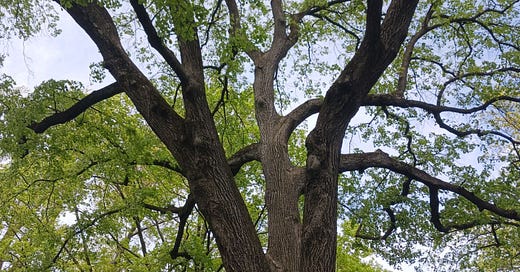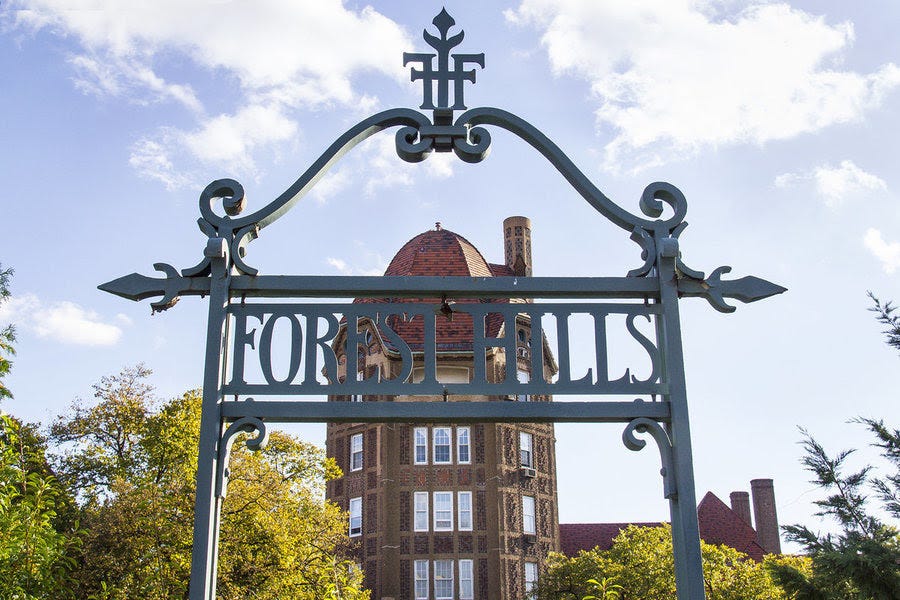A Celebration of Beauty
I created the first draft of this post more than a month ago during a stroll through Forest Hills Gardens, arguably the most beautiful neighborhood in Queens New York. I mention the place in part because this post is about this place and all the physical spaces we inhabit as we extend ourselves into the digital sphere.
Pulled and pushed by the perverse incentives of the ‘attention economy’, we often neglect the physical world as we get absorbed in what Jean Beaudrillard called “simulations and simulacra”. As an ‘Extremely Online’ citizen of our post-reality, I welcome the shift of focus to my physical world. Using autoethnography as a genre also allows me to notice connections between my local news and the main themes of my Substacks.
Learning from Nature
I increasingly notice the beauty of the worlds now emerging from the ruins of the worlds we continually lose to cultural entropy. The simple beauty of the emerging world draws me to dialogue and the daily work of autoethnography. There is no vacation from this work because, for me, there's no way to distinguish it from life itself. I write for a living even when nobody pays me.
My mood is in part celebratory, and I think the most important thing I celebrate are the new possibilities for using advertising-free media to construct tabernacles to shield us from the pathologies of the attention economy. There is no advertising in nature, only the free flow of relevance realization.
Sound and Silence
I haven't produced many podcasts, mainly because I don't have any experience in audio production. It's also hard to find a place in New York to record my podcasts without noisy distractions. But another Substacker inspired me not only to record podcasts during my walks but also to rethink the very idea of distractions. Whatever background sounds you hear — e.g., chirping birds, speeding cars, angry pedestrians — are part of the story. This is the nature and distinctive value of autoethnography.
Mini-podcast: Welcome Back!
The Architecture of the Tabernacle
I certainly don't want to reduce the idea of a media tabernacle to Substack or to M2 Dialogue. Substack isn't the tabernacle. Neither is any specific publication or community. The prima materia of this tabernacle are its governing principles, not its visible pillars.
There are many ways to express the governing principles. One of these ways is to acknowledge the responsibilities of all those who enter the tabernacle. I did that, at least in part, here and here.
I'd like to qualify these acknowledgments in at least two ways. First, no written rules or codes or definitions can capture the meaning of dialogue. We can only live the meaning of dialogue dialogically. Second, let's not get hung up on metaphors. For example, what I call the tabernacle or Rumi's Garden, Marshall McLuhan describes as models or Noah's arks:
The artist picks up the message of cultural or technological challenge decades before its transforming impact occurs. He, then, builds models or Noah's arks for facing the change that is at hand. “The war of 1870 need never have been fought had people read my Sentimental Education,” said Gustave Flaubert.
(Source: Understanding Media: The Extensions of Man, Chapter 7, First MIT Press Edition, page 65).
Whether we think of the artist as creating a model, a tabernacle, a garden, or something else, the metaphor is not the territory, but it meets Alfred Korzybski's cartographic standard: it mirrors the structure of the territory, which makes the metaphor useful. At the same time, the meaning and redemptive potential of the metaphor collapses when we reduce it to a literal/physical object like the remnants of Noah's Ark supposedly buried somewhere around Mount Ararat.

A Fragile Beauty
Whatever metaphors we apply to what shields us from the meta-vampirism of the post-reality wilderness, the awesome beauty of these sanctuaries makes life livable, and as meaning-secreting creatures inhabiting meaning-destroying environments, we increasingly find peace in the struggle to protect these sanctuaries from the barbarians at the gate.
Based on my recent experience, I find it easier to fight the barbarians than to resolve the recent spike in Substack’s technical difficulties. I’ve always valued Substack’s elegant simplicity. I loved the fact that the platform simply worked. It pains me that the platform now suffers not only from self-inflicted wounds (e.g., underfunded customer service and technical support) but also hostile treatment by advertising-polluted media, including Twitter and LinkedIn.
It’s hard to write or speak non-reductively about the architecture and cybersecurity of our media sanctuaries, and I welcome input from the mythologists and biblical exegetes among my subscribers. I'm certainly curious about this idea that we might learn something useful from what the Bible and other ancient texts reveal about the integrity and security of tabelnacles and arks.
More importantly, I urge
to take action on tech-support ticket #341142. Also, please don’t add more features to Substack than you can manage sustainably. Also, Substack’s customer service should not be stretched so thin.My Tabernacle
I’ll conclude with a tour of my tabernacle, expanding on what I shared with my LinkedIn connections yesterday in response to the prompt: “What do you want to talk about?”
I start with my two income-generating Substacks.
M2 Dialogue (M2D). Through M2 Dialogue, I've been writing about gaps between stories and realities and the pandemic of pseudo-solutions to misdiagnosed problems. I've also been writing about authors whose work I find urgently relevant: e.g., Marshall McLuhan, Ivan Illich, Martin Buber, Rene Girard, and Baruch Spinoza. I think of M2D as my main Substack incubator.
Dialogue as a Service (DaaS). As a DaaS practitioner, I want to talk about the state of dialogue and the potential and pitfalls of diologic responses to the pollution of our media ecology. I also want to talk about liberating dialogue from the tyranny of established advisory arts.
Beyond my income-generating work, I want to talk about the editorial priorities of my three free Substacks:
The Medium Is the Message (MISM). As the publisher of MISM, I want to talk about Understanding Media. By that, I mean both the seminal work by Marshall McLuhan and our day-to-day adventures with our ‘extensions’. I also want to talk about Wall Street's prevailing valuation paradigm that systematically misdirects capital toward ecology-destroying media at the expense of regenerative alternatives.
End of Theory (EoT). EoT is my main Substack dedicated to the research, development and propagation of Bullshit Conversion Technology.
BS”D (With the Help of Heaven). I've been drawing more deeply on the Jewish tradition where I gained my introduction to the intersection of matter and metaphor. BS”D is my first Jewish-themed Substack, and I welcome subscriptions from Jews and non-Jews alike, with a special invitation for other “Jews Among Jews”.
Where’s Your Tabernacle?
Before I conclude with further-reading recommendations on subjective cartography, I’ll share the most surprising observation based on my experience on Substack so far: Even my most engaged subscribers have no interest in using Substack (or any similar platform) for themselves.
It also surprises me to see smirking or eye-rolling comments on LinkedIn or Twitter about “Oh, all these people starting Substacks…” As I wrote in Attention Please!:
The problem isn't that there are now so many Substacks seeking attention, but that there are still so many people on advertising-driven media limiting their self-expression to statements indistinguishable from AI-generated text: e.g., "Congrats on the new position!"
From the subscribers unattracted to Substack, I’d love to hear where they find their refuge from the pathologies of the attention economy.





